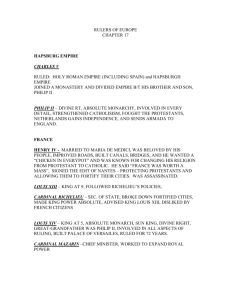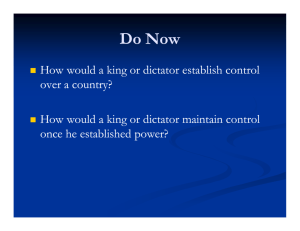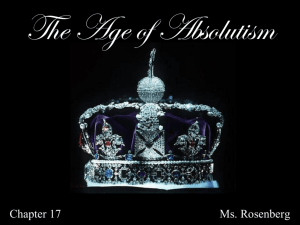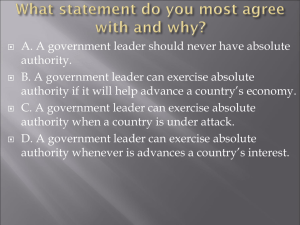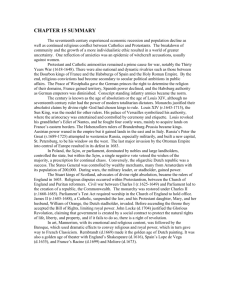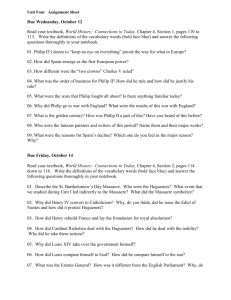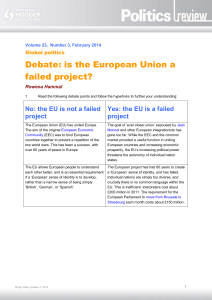CHAPTER 4 SECTION 5 Note Taking Study Guide p. 72) Russia's
advertisement
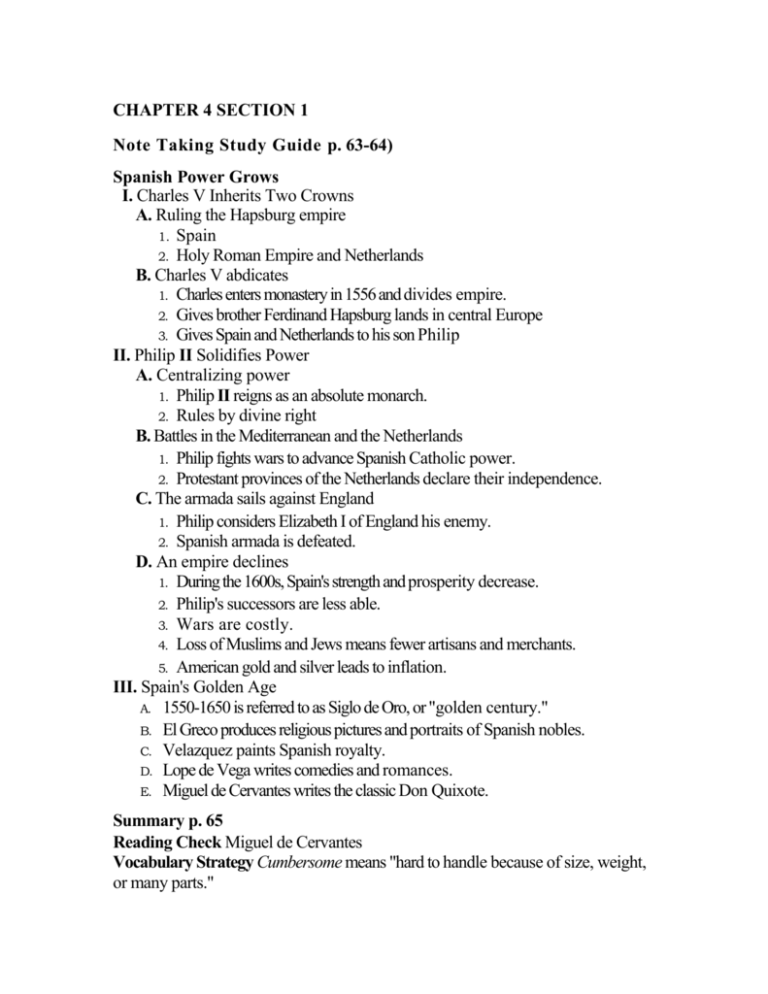
CHAPTER 4 SECTION 1 Note Taking Study Guide p. 63-64) Spanish Power Grows I. Charles V Inherits Two Crowns A. Ruling the Hapsburg empire 1. Spain 2. Holy Roman Empire and Netherlands B. Charles V abdicates 1. Charles enters monastery in 1556 and divides empire. 2. Gives brother Ferdinand Hapsburg lands in central Europe 3. Gives Spain and Netherlands to his son Philip II. Philip II Solidifies Power A. Centralizing power 1. Philip II reigns as an absolute monarch. 2. Rules by divine right B. Battles in the Mediterranean and the Netherlands 1. Philip fights wars to advance Spanish Catholic power. 2. Protestant provinces of the Netherlands declare their independence. C. The armada sails against England 1. Philip considers Elizabeth I of England his enemy. 2. Spanish armada is defeated. D. An empire declines 1. During the 1600s, Spain's strength and prosperity decrease. 2. Philip's successors are less able. 3. Wars are costly. 4. Loss of Muslims and Jews means fewer artisans and merchants. 5. American gold and silver leads to inflation. III. Spain's Golden Age A. 1550-1650 is referred to as Siglo de Oro, or "golden century." B. El Greco produces religious pictures and portraits of Spanish nobles. C. Velazquez paints Spanish royalty. D. Lope de Vega writes comedies and romances. E. Miguel de Cervantes writes the classic Don Quixote. Summary p. 65 Reading Check Miguel de Cervantes Vocabulary Strategy Cumbersome means "hard to handle because of size, weight, or many parts." Reading Skill Philip was a major supporter of the arts. Arts and learning flourished during this time, which is called Spain's Siglo de Oro, or "golden century." This period produced several significant artists and writers, including El Greco and the novelist Miguel de Cervantes. The literary work Don Quixote by Cervantes is considered to be Europe's first modern novel. Review Questions 1. The Hapsburg empire included the Holy Roman Empire and the Netherlands. 2. Philip ruled with complete authority over the government and the lives of the people. CHAPTER 4 SECTION 2 Note Taking Study Guide, p. 66 The Reign of Louis XIV Louis XIV No meetings of Estates General; Made France the leading power of Europe; Sun as a symbol; Expanded bureaucracy; Built strong French army; Made Versailles a symbol of power; Used rituals to reduce threat from nobles; Patronized the arts Summary p. 67 Reading Check Louis XIV fought costly wars to extend French borders. He also revoked the Edict of Nantes, which led to hundreds of hard-working Protestants fleeing the country. Vocabulary Strategy Erode means "wear away or disintegrate." Reading Skill Louis XIV governed as an absolute monarch. Under his rule, the royal government expanded, trade and commerce fueled the country's economy making France the wealthiest country in Europe, and a strong army enforced his policies at home and abroad. Review Questions 1. He issued the Edict of Nantes to protect Protestants. This granted the Huguenots religious liberty and other freedoms. 2. Intendants were royal officials who collected taxes, recruited soldiers, and carried out the king's policies in the provinces. CHAPTER 4 SECTION 3 Note Taking Study Guide p. 68 Evolution of the English Parliament -Tudors consult with and control Parliament. Parliament insists Charles I gain consent before raising taxes. -The Long Parliament declares that Parliament cannot be dissolved without its own consent. - Napoleon consolidates his power by strengthening the central government. -Parliament forces are victorious in English Civil War. -Under Cromwell, England becomes the Commonwealth. -After Cromwell's death, Parliament invites Charles II to return as king. -William and Mary accept the English Bill of Rights, which ensures the power of Parliament over the monarchy. -Glorious Revolution creates limited monarchy. Prime minister becomes chief official of the British government. On-Level Summary (p. 69 Reading Check the peaceful overthrow of James II. Vocabulary Strategy Tolerate means "to respect other's beliefs without sharing them." Reading Skill Oliver Cromwell, the leader of Parliament forces, guided them to victory and the king was put to death. Parliament offered the crown to James's Protestant daughter Mary, and her husband William. However, William and Mary had to accept the English Bill of Rights. Review Questions 1. It changed from a monarchy to a republic. 2. Protestants thought he planned to restore the Roman Catholic Church to power in England. CHAPTER 4 SECTION 4 Note Taking Study Guide, p. 70 The Rise of Austria and Prussia Rise of Austria Austrian ruler keeps title of Holy Roman Emperor. Ferdinand, Hapsburg king of Bohemia, tries to suppress Protestants and assert power over nobles. Hapsburgs extend their lands. Maria Theresa strengthens Hapsburg power. Rise of Prussia Hohenzollern rulers take over German states. Frederick I builds one of the best-trained armies in Europe. Frederick II earns the name "Frederick the Great." Summary p. 71 Reading Check These treaties were intended to bring peace to Europe and settle other international problems. Vocabulary Strategy Aspired means "aimed; sought." Reading Skill The war devastated the German states. Mercenaries burned villages, destroyed crops, murdered and tortured villagers. This led to famine and disease, which caused severe depopulation. Review Questions 1. It began when Ferdinand wanted to control Protestants and assert royal power over nobles. This led to several revolts followed by a widespread European war. 2. The murder and torture of villagers by mercenaries led to widespread famine and disease. CHAPTER 4 SECTION 5 Note Taking Study Guide p. 72) Russia's Absolute Monarchs Peter Visited European countries Controlled the Church and nobles Created a standing army Defeated the Swedes Built St. Petersburg Both Adopted Western ideas Catherine Established warm-water port on Black Sea Enlightened ruler Took eastern Poland Summary p. 73 Reading Check on territory along the Baltic Sea won from Sweden Vocabulary Strategy Stipulated means "made a specific demand." Reading Skill Possible answer: Peter the Great; and Catherine the Great modernize Russia.Review Questions 1. He began a policy of westernization and began adopting Western ideas, technologies, and culture. 2. She expanded Russia's borders by defeating the Ottoman empire, and she acquired the warmwater port on the Black Sea.
